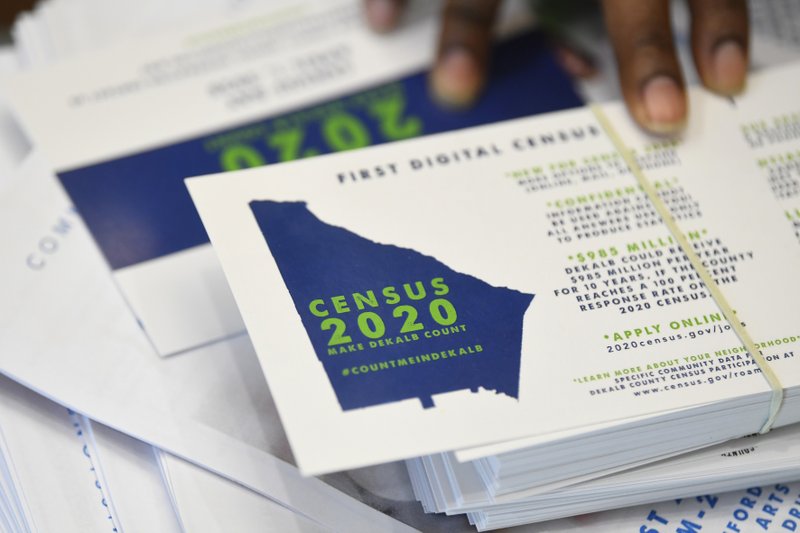When the Census Bureau reported an increase in the number of people without health insurance in America, it sent political partisans reaching for talking points on the Obama-era health law and its travails. But the new numbers suggest that fears of the Trump administration’s immigration crackdown may be a more significant factor in the slippage.
Overall, the number of uninsured in the U.S. rose by 1.9 million people in 2018, the agency report this past week. It was the first jump in nearly a decade. An estimated 27.5 million people, or 8.5% of the population, lacked coverage the entire year. Such increases are considered unusual in a strong economy.
The report showed that a drop in low-income people enrolled in Medicaid was the most significant factor behind the higher number of uninsured people.
Hispanics were the only major racial and ethnic category with a significant increase in their uninsured rate. It rose by 1.6 percentage points in 2018, with nearly 18% lacking coverage. There was no significant change in health insurance for non-Hispanic whites, blacks and Asians.
“Some of the biggest declines in coverage are coming among Latinos and noncitizens,” said Larry Levitt of the nonpartisan Kaiser Family Foundation, who tracks trends in health insurance coverage. “These declines in coverage are coming at a time when the Trump administration has tried to curb immigration and discourage immigrants from using public benefits like Medicaid.”
Health care is the defining issue for Democrats vying for their party’s 2020 presidential nomination. Candidates wasted no time in Thursday’s debate highlighting the split between progressives such as Sens. Bernie Sanders and Elizabeth Warren , who favor a government-run system for all, including people without legal permission to be in the country, and moderates like former Vice President Joe Biden. He supports building on the Affordable Care Act and adding a new public plan option, open to U.S. citizens and legal residents.
Although the candidates did not dwell on the uninsured rate, Democratic congressional leaders have said the census figures show the administration’s “sabotage” of the Obama health law.
The administration issued a statement blaming the law’s high premiums, unaffordable for solid middle-class people who do not qualify for financial assistance. “The reality is we will continue to see the number of uninsured increase until we address the underlying issues in Obamacare that have failed the American people,” the statement said.
Patterns in the data indicate there’s more to the story.
Health economist Richard Frank of Harvard Medical School said the data “suggest that we are dealing with immigration … potentially in some unexpected ways.” Frank was a high-ranking health policy adviser in the Obama administration.
The uninsured rate for foreign-born people, including those who have become U.S. citizens, also rose significantly, mirroring the shift among Hispanics.
Frank noted that immigrant families often include foreign-born and native-born relatives, “and you can imagine the new approach to immigration inhibiting these people from doing things that would make them more visible to public authorities,” such as applying for government health care programs.
Immigrants’ fears may also be part of the reason for a significant increase in the number of uninsured children in 2018, said Katherine Hempstead, a senior health policy expert with the nonpartisan Robert Wood Johnson Foundation, which works to expand coverage. Among immigrant children who have become citizens, the uninsured rate rose by 2.2 percentage points in 2018, to 8.6%. The increase was greater among kids who are not citizens.
“There are a lot of kids eligible for public coverage but not enrolled because of various things that make it less comfortable for people to enroll in public coverage,” said Hempstead.
The administration’s “public charge” regulation, which could deny green cards to migrants who use government benefits such as Medicaid was finalized this year. But other efforts to restrict immigration, including family separations at the U.S.-Mexico border, were occurring in the period covered by the report.
“People are interpreting ‘public charge’ broadly and even though their kids are eligible for Medicaid because they were born in this country, they are staying away,” said Hempstead. Children’s coverage often follows their parents’ status.
Other factors could also be affecting the numbers:
—The report found a statistically significant increase in solid middle-class people who are uninsured. Health care researcher and consultant Brian Blase, who until recently served as a White House adviser, said it appears to reflect people who cannot afford high ACA premiums. Blase said Trump policies rolled out last year should provide better options for this group. The changes include short-term health insurance plans, health reimbursement accounts and association health plans.
—Experts are debating the impact of a strong job market on the decline in Medicaid enrollment. It’s possible that some Medicaid recipients took jobs that boosted their earnings, making them ineligible for benefits. But if those jobs did not provide health benefits, then the workers would become uninsured. The Census Bureau report showed no significant change in workplace coverage.
(AP)












2 Responses
Immigrants are covered by Obamacare, Medicaid or employer insurance. Non-immigrant aliens (be there person wanting to immigrant, seeking temporary employment, students, or tourists) are covered by their home country’s health insurance (and most of the countries that most “illegal aliens” come from provide government sponsored health care (Bernie would approve).
Yes. Let’s be clear on this. The headline should read “Rise in Health Uninsured may be linked to ILLEGAL Immigrants’ Fears.”